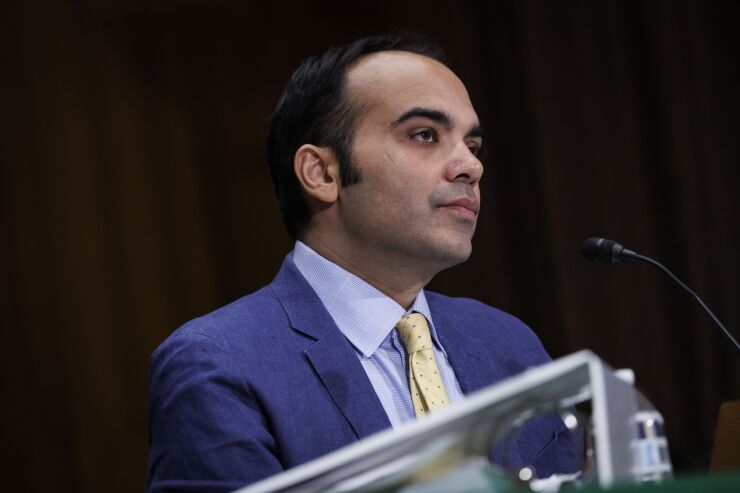
Bank overdraft revenue fell nearly 50% in the fourth quarter compared with three years earlier, according to new Consumer Financial Protection Bureau data.
Banks reported $1.6 billion of overdraft revenue in the final three months of 2022, which was down 48% from the fourth quarter of 2019, the CFPB said, citing bank call report data.
For the full year, banks reported $7.7 billion in overdraft and nonsufficient-funds fees, a 35% drop from 2019. The decline is notable given that the eight largest banks reported a combined $11 billion to $12 billion of annual revenue from such fees for each of the five years from 2015 to 2019.
Financial institutions have dramatically cut overdraft fees in the past few years after many years of public pressure. Consumers saved a significant amount of money in the process.
Many households saved more than $150 a year in 2022 compared with 2019 due to the reductions in overdraft and nonsufficient-funds fees, the CFPB said.
Rohit Chopra, the agency's director, announced a crackdown on overdraft fees in 2021. Yet, many point to Bank of America's decision in early 2022 to slash overdraft fees from $35 to $10 for having a ripple effect across the industry, pressuring other banks to follow suit.
The CFPB notably found that banks have not increased other fees to make up for the lost overdraft revenue. Account maintenance and ATM fees remained flat from 2019 to 2022, the bureau said.
"There is no clear correlation between decreases in overdraft/NSF and increases in other listed fee revenue," the CFPB said. "We will continue to track overdraft/NSF fees and are considering rulemaking activities related to these fees."
Chopra offered some praise for banks' efforts to reduce overdraft fees at a recent industry conference.
"We are very gratified that this industry seems like it's competing again on [overdraft]," Chopra said at a conference of the Consumer Bankers Association in March. "This has been a healthy move."
Chopra said the bureau is monitoring overdraft charges ahead of an upcoming rulemaking. The CFPB is in the
"We're in the early stages [of a rulemaking] and thinking about what might be the options to make sure that this industry doesn't backtrack," Chopra said in March.
Changes that began at individual banks in 2021 gained steam this year, as many large and midsize banks reduced their reliance on overdraft-related charges. Federal and state policymakers were key catalysts of the sea change.
Specifically, the CFPB is considering whether to propose changes by late 2023 to Regulation Z, which stems from the Truth in Lending Act. The CFPB is also looking at nonsufficient-funds fees, which are charged by banks when consumers overdraw their accounts. Until recently, NSF fees were a significant source of fee revenue for banks, though many financial institutions have voluntarily stopped charging such fees.
The CFPB looked at banks of all sizes, and much of the focus has been on the eight largest banks, comparing their overdraft and NSF fees to other fee revenue in 2019 to get insight on the changes pre-pandemic. BofA had the most significant decline by far with a 91% drop in overdraft fees, reflecting the reduction of its overdraft fee to $10, and the elimination of overdraft fees on ATM withdrawals and of NSF fees.
Meanwhile, overdraft fees revenue dropped at TD Bank Group, U.S. Bancorp and PNC Financial Services Group by more than 50% from 2019 to 2022, while JPMorgan Chase and Wells Fargo had 45% and 44% declines, respectively. Truist Financial had a 38% drop, and Regions Bank experienced a 37% decline. All of the largest banks have eliminated NSF fees entirely, the CFPB said.
Perhaps the biggest surprise is that some banks are not raising other fees to make up for the lost overdraft revenue. BofA again led the pack with other fee revenue falling 7% last year, while U.S. Bank's fee revenue fell 6%. By comparison, TD Bank's other fee revenue increased 11% while PNC's jumped 28%.
In terms of overall dollars, the top eight banks saw a $3.4 billion decline in overdraft and NSF fee revenue in 2022 compared with a net increase of just $97 million in other fee revenue. Banks with assets over $1 billion have been required to report overdraft and NSF fees in call report data since 2015.






